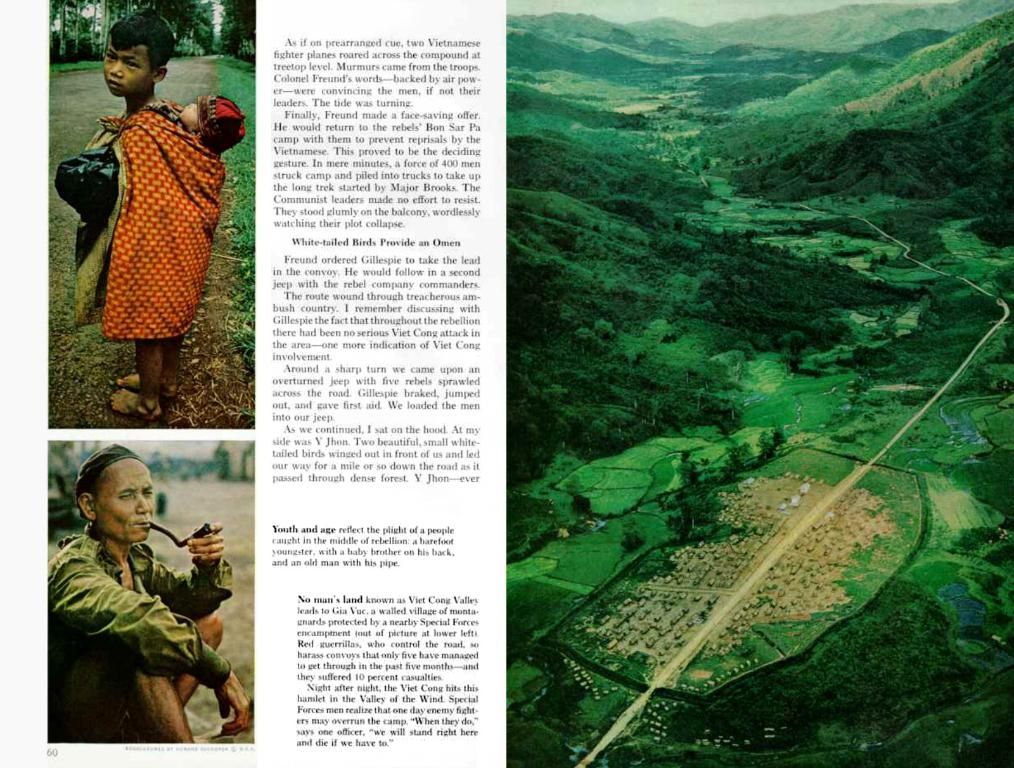Comprehensive Overview of Salamanca - The Golden City
Golden City, Golden Vibes: A Tour of Salamanca's Architectural Masterpieces
Known as the "Golden One," or La Dorada, the city of Salamanca in western Spain gleams with its stunning sandstone architecture. Nestled in a hilly region near the Tormes River, the capital of the Province of Salamanca offers a delightful blend of history, culture, and mouthwatering culinary delights. While exploring Salamanca, don't miss these top architectural landmarks that showcase the city's rich heritage.
Plaza Mayor: The Heart of Salamanca
Come and indulge in the charms of Plaza Mayor, a Baroque-inspired public square right in the heart of the city. Surrounding this beloved spot are a variety of shops, restaurants, smaller boutiques, and even city hall. Constructed between 1710 and 1755, the Plaza Mayor was built by King Philip V, and its influence on Salamanca's Old City was a key factor in earning it a spot as a UNESCO World Heritage Site in 1988[1][3].
Fun Fact: Back in the day, Plaza Mayor was used for bullfighting[1].
Casa de las Conchas: A House Beautiful
Translating to the "House of the Shells," Casa de las Conchas is a breathtaking example of late Gothic architecture. Decorated with 300 intricate shell ornaments, the building is a testament to the owner's membership in the Order of Santiago[2]. The elegant construction served as the city's main library for many years.
The Old and New Cathedrals
The Old Cathedral (Catedral Vieja) and New Cathedral (Catedral Nueva) stand proudly in the Salamanca skyline. The Old Cathedral showcases a blend of Romanesque and Gothic styles, while the New Cathedral boasts late Gothic and Baroque designs. The Old Cathedral, dating back to the 14th century, is known for its frescoes and the Torre del Gallo (Gallows Tower), while the New Cathedral features towering ceilings, ornate altarpieces, and even a modern astronaut carving[1][4].
Fun Fact: Jeronimo Garcia, a stoneworker during a restoration, was allowed to leave some contemporary carvings on the New Cathedral's façade in 1992, including an astronaut and a dragon eating an ice cream cone[4].
Casa Lis: An Eye-Catching Gem
Don't miss Casa Lis, a stunning Art Nouveau building that steals the show with its intricate iron grates, blue, and green stained glass panels, and unique architectural style. Originally built as a mansion for a local businessman in the 19th century, it has since become a public museum[5]. Inside, marvel at the beautiful Art Nouveau and Art Deco exhibits, from glassware and ceramics to jewelry and dolls[5].
The Tormes River and The Roman Bridge
Take a stroll by the Tormes River, which winds its way through the southern part of the city, and admire the ancient Roman Bridge (Puente Mayor del Tormes) that has graced the river since the first century A.D.[2]. With its 26 semicircular arches, it's a truly picturesque bridge that looks especially enchanting when it is illuminated in the evening[2].
Salamanca University
As one of the oldest universities in Europe, the University of Salamanca is a must-visit. Founded in 1218 and officially recognized in 1254, this esteemed institution stands proudly in the Old City[4][5]. The façade features a popular carving of a frog on a skull, which is said to be the symbol of the university[5].
Gastronomic Specialties: Meat Pies, Spicy Sausages, and More
Hornazo
Try the hearty hornazo, a meat pie filled with layers of chorizo sausage and pork loin. This traditional holiday dish, enjoyed during Easter and after the Lunes de aguas festival, can be found in local bakeries and grocery stores year-round[5].
Farinato
Don't leave Salamanca without tasting their iconic sausage, farinato[5]. Unlike regular sausages, this unique offering is made from pork fat, breadcrumbs, flour, onion, paprika, anise, and brandy, creating a flavor that is distinctly Salamanca. Farinato is often enjoyed with fried or scrambled eggs[5].
Fun Fact: The most popular way to eat farinato in Salamanca is as a side dish[5].
Sources:1. "Plaza Mayor." Spain Hospitality, 2021, https://www.spain-hospitality.com/plaza-mayor-salamanca/.2. "Five Stunning Sites in the City of Salamanca." Jack's Travel Maps, 2017, https://jackstravelmaps.com/five-stunning-sites-in-the-city-of-salamanca/.3. "Salamanca, Spain." UNESCO World Heritage Centre, 2002, https://whc.unesco.org/en/list/449/.4. "A Architectural Guide to Salamanca." Daydreaming in Paris, 2018, https://daydreaminginparis.com/salamanca-architectural-guide/.5. "Salamanca, Spain Travel Guide." Travelo, 2021, https://travelo.io/salamanca-travel-guide/.
Gastronomy plays a significant role in Salamanca's lifestyle, with home-and-garden stores offering unique items that reflect the cultural influences of the city. For travelers looking to incorporate local flavors into their journey, learning traditional gastronomic specialties such as the hearty hornazo and the iconic farinato, coupled with a stroll along the picturesque Roman Bridge, creates an immersive and memorable experience. To wrap up a day of exploring Salamanca's architecture, unwinding in a cozy home-and-garden setting can be the perfect way to embrace the city's vibrant atmosphere.





